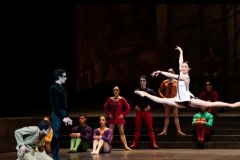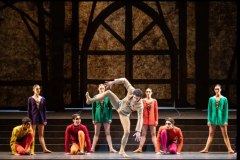Notre-Dame de Paris
December 2025 | ||||||
|---|---|---|---|---|---|---|
Mo | Tu | We | Th | Fr | Sa | Su |
Duration : 1h55 with 1 interval
Opening:
First part 65 minutes
Intermission 20 min
Second part 30 minutes
End
For his first choreography at the Paris Opera in 1965, Roland Petit masterfully constructed a colourful fresco, as theatrical as it is intense, from Victor Hugo’s lavish novel Notre-Dame de Paris.
Between the four main characters, the beautiful Esmeralda in love with Captain Phoebus, Frollo tormented by his desire, and the hunchback Quasimodo, the tragic tale unfolds against the backdrop of the Middle Ages populated by a fickle crowd, ever shifting from elation to cruelty.
Combining neoclassical language and the spirit of music-hall, Roland Petit surrounded himself with the leading creative artists of his time: Maurice Jarre for the music, René Allio for the sets and Yves Saint Laurent for the costumes, which he wanted to be “as colourful as the stained glass windows of a cathedral”.
CHARACTERS
Quasimodo: the bell-ringer
Esmeralda: the Bohemian
Frollo: the archdeacon of Notre-Dame
Phoebus: the captain of the King’s Archers
Synopsis
First part
Acte 1 :
1 – The Feast of Fools
In the year of Our Lord 1482, in the Paris of Louis XI, an area lying between Notre-Dame, the Louvre and the Châtelet tribunal – God, the King and Justice – the bourgeoisie and the riffraff gather together to celebrate the Feast of Fools. Whoever can outdo his rivals, with grimaces and foolery of every sort, will carry off the title of “Pope of Fools”. Suddenly there appears a monstrous being that eclipses all others: hunchbacked and lame, it is Quasimodo, the bell-ringer of Notre-Dame. His deformity, however, is not feigned but real. At the sight of him, the crowd remains for an instant seized with stupor, then, cruelly mocking, proclaims him “Pope of Fools” and in a grotesque procession parades the poor cripple who is confusedly happy with his derisory title.
2 – Prayer
But someone disrupts the festivities: Claude Frollo, the archdeacon of Notre-Dame, who reminds the people that life is not only a 21 round of pleasures and that they must pray and repent. Ashamed, Quasimodo comes, like a faithful hound, to lie down at his feet, for it is to this seemingly hard and austere priest that he owes his life. Abandoned as a child, condemned to perish in the flames by a few gossips who saw in his monstrosity the mark of the devil, it was Frollo who took him in, brought him up and made him the cathedral bell ringer. Beneath his mask of coldness and severity, Frollo has been concealing a tormented soul, ever since he saw a certain “Egyptian” by the name of Esmeralda, dancing in front of Notre-Dame. His attempts to pray are in vain: the sound of the tambourine throbs unceasingly in his ears, – an unbearable obsession.
3 – Esmeralda
And here she is, so beautiful “that God is said to have preferred her to the Virgin”, dancing with her fiery body, like an invitation to love. Mad with desire, Frollo orders Quasimodo to go and fetch Esmeralda and bring her to him.
4 – The Court of Miracles
Then begins a terrifying pursuit, with Quasimodo hunting for Esmeralda in Paris, amongst the people of the shadows: the paupers, cripples, beggars, pick-pockets and cut-throats, all those outcasts from the Court of Miracles whose kingdom is the night.
5 – The Pilory
Esmeralda succeeds in escaping from Quasimodo thanks to the intervention of a company of archers led by Captain Phoebus. The Bohemian now finds herself attracted to the handsome officer, whilst Quasimodo, who has been arrested, is led to the pillory by the archers who beat him up beneath the indifferent eyes of the bystanders. Only Esmeralda, moved by the suffering of this creature whose appearance once frightened her, makes her way through the crowd to give him something to drink. This simple gesture of pity, doubtless the only one that anybody has ever yet shown him, and from a girl as beautiful as he is ugly, overwhelms the poor devil and changes the course of his destiny.
6 – The Soldiers
Phoebus marches at the head of his troops. Like a mating ritual for Esmeralda.
7 – The Tavern
Phoebus lures the gypsy girl to a tavern frequented by drunkards and ruffians. Esmeralda soon finds herself in the arms of her handsome captain. But the lovers are not alone. In the shadows, Claude Frollo is watching, intoxicated with rage and jealousy at their lovemaking. Unable to contain himself, Frollo stabs Phoebus and flees, leaving Esmeralda distraught. The soldiers of the watch seize the Egyptian, whom appearances incriminate, and take her away.
8 – The Trial
Accused of Phoebus’s murder, Esmeralda is taken before the judges.
9 – The Scaffold
Condemned for debauchery, homicide and witchcraft, the gypsy Esmeralda is to be hanged. She is already in the hands of the executioner when, suddenly, Quasimodo, who has not forgotten the Bohemian’s kindness, appears from nowhere. Pushing aside the guard, he rescues Esmeralda and carries her inside the cathedral. In the safety of Notre-Dame, Esmeralda benefits from the right of sanctuary. Claude Frollo, in spite of his chagrin, is obliged to hold back the crowd trying to break into the church. Disappointed to be deprived of its prey, but with a renewal of religious feeling, the mob content themselves with a joyful cry of “Noel!” to celebrate the Saviour’s birth.
Second part
Acte 2:
10 – The Belfry of Notre-Dame
Constantly on the watch, Quasimodo makes a tour of his domain to ensure that nothing threatens his beautiful protégée. He cries out for joy, hanging from the bells that he rings in loud peals.
11 – Esmeralda and Quasimodo
Esmeralda appears and tenderly shows her gratitude to the bell- ringer who, ashamed of his deformity, is nevertheless emboldened – with her encouragement – to take the young girl by the hand and, full of happiness, he shows her around his refuge. Weary, Esmeralda gently falls asleep, watched over by Quasimodo. Believing her to be safe, the hunchback withdraws. But the cathedral is also the domain of the archdeacon, Frollo. Taking advantage of Quasimodo’s absence, he approaches to torment Esmeralda. She repulses his advances in disgust. Then, carried away by his delirious passion, the man strikes, as if to break the body that resists him forever.
12 – The nightmare / The attack on the cathedral
Justice cannot long be denied! A parliamentary decree having revoked the right of sanctuary, the soldiers attack the cathedral.
The people follow and Quasimodo, powerless, sees soldiers and dishevelled women, as in a nightmare, pour inside like the Furies of ancient times. He tries vainly to stop them by pouring molten lead over them but, defeated by their numbers, he has to give up the fight. Esmeralda is taken.
13 – Death
A long funeral procession leads Esmeralda to the scaffold. This time, nothing can prevent the hangman from accomplishing his task. The beautiful gypsy is soon no more than an inert form. And the sound of the tambourine that haunted the archdeacon’s nights dies with Esmeralda. Quasimodo finally understands the evil power of this man, throws himself upon him and strangles him. The body of the accursed priest rolls down the steps of the scaffold whilst Quasimodo slowly carries away the limp remains of the woman he loved.
Program and cast
Ballet in two acts and thirteen scenes After Victor Hugo
Creative team
Roland Petit: Choreography
Maurice Jarre: Music(1924‑2009)
Roland Petit: Libretto
Jean-François Verdier: Conductor
René Allio: Set design
Yves Saint Laurent: Costume design
Jean-Michel Désiré: Lighting design
With the Paris Opera Étoiles, Premières Danseuses, Premiers Danseurs and Corps de Ballet
The Paris Opera Orchestra
Paris Opera Bastille
RM Europa Ticket GmbH is an officially accredited ticket reseller of/by Opera National de Paris.
Agency number: 4848428
Opéra Bastille
A great modern theatre
The Opéra Bastille is the work of the Canadian-Uruguayan architect Carlos Ott, who was chosen in November 1983 after an international competition that attracted entries from some 1,700 architects. The theatre was inaugurated on July 13th 1989.
Its architecture is marked by transparent façades and by the use of identical materials for both the interiors and the exteriors.
With its 2,700 acoustically consistent seats, its unique stage facilities, its integrated scenery, costume and accessory workshops, as well as its numerous work areas and rehearsal rooms, the Opera Bastille is a great modern theatre.
Stage facilities
Orchestra pit, mobile and adjustable, can be covered; at its largest it can house 130 musicians
Main stage, 45 m high, 30 m wide, 25 m deep, made up of 9 elevators allowing several levels to be created and supported by three main elevators, which bring scenery up from below stage
Clearing zones, 4 storage areas with the same dimensions as the stage
Backstage area, with its scenery turntable
Circulation area, scenery temporarily stored between the stage, workshops and rehearsal stage
Rehearsal stage, the Salle Gounod, with its orchestra pit and dimensions identical to those of the main stage
The building
Area at ground level: 22,000 m²
Floor area: 160,000 m²
Total height: 80 m (including 30 m below street level)
The auditoriums
The main auditorium
Area: 1,200 m², 5% of the total for the building
Dimensions: 20 m high, 32 m deep, 40 m wide
Number of seats: 2,703
Materials: blue granite from Lannelin in Brittany, pearwood from China, glass ceiling
The amphitheatre
Area: 700 m²
Depth : 21.4 m
Number of seats : 450
Materials: white breccia marble from Verona, staff ceiling
The Studio
Area: 280 m²
Depth: 19,5 m
Number of seats: 237
Materials: white breccia marble from Verona and pearwood

 EN
EN DE
DE IT
IT FR
FR ES
ES RU
RU JP
JP RO
RO
 Seating plan
Seating plan 


